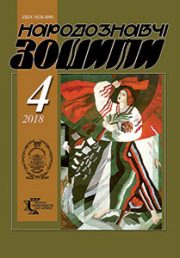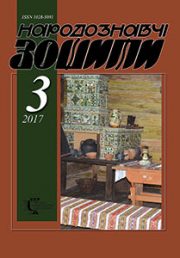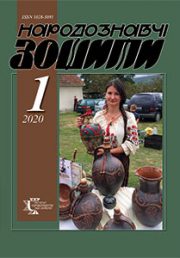The Ethnology Notebooks. 2019, № 6 (150), 1379—1392
UDK7. 046; 7.041.6
DOI https://doi.org/10.15407/nz2019.06.1379
KOSIV Roksolana
ORCID ID: http://orcid.org/0000-0002-1202-1488
Doctor in Art Studies,
Associate professor, Lviv National Academy of Arts
Senior scholar, National Museum in Lviv named after Andrey Sheptytsky
38, Kubiiovycha Street, 79011, Lviv, Ukraine
e-mail: lanakosiv@yahoo.com
Abstract. Problem statement. The theme of the ancestry of Christ, visualized by the plot of the Tree of Jesse, is highly developed in the Ukrainian art of the second half of the 17th—18th cc. However, the Tree of Jesse plot was never the subject of a separate study on the characters of the lineage of Christ. At the royal gates of Ukrainian iconostases, the personality of the Tree of Jesse is treated quite schematically and mostly it is not clear who is depicted or carved. Icons represent more details, thus their research is relevant for the study of Tree of Jesse iconography.
The purpose of the work is to use the example of three icons on the canvas of the second half of the 17th c. from the National Museum in Lviv named after Andrey Sheptytsky to explore the Ukrainian iconography of the lineage of Christ in connection with its development in the broad European context and in the context of the Ukrainian art.
The methods of iconographic and iconological analysis, semiotics, formal analysis and reconstruction are used in the research. The artworks are analyzed within the history of subject development with the consideration of the cultural context.
Results. In medieval Western European or Balkan iconography, the figures of the Tree of Jesse composition could portray not only those mentioned in the genealogy of Christ in the Gospels of Matthew and Luke (after the Jesse), but also those prophets and patriarchs who proclaimed the sacrifice of Christ. Works of art with the Tree of Jesse plot in the Ukrainian medieval art are unknown. The connection between «The Tree of Jesse» icons on canvas and church murals is highlighted.
Conclusions. In the 17th c. Ukrainian iconography of the Tree of Jesse, a «short» story with 12 Old Testament kings or kings and prophets dominated. The theme of the genealogy of Christ finds parallels with the genealogical trees, common in the 17th and 18th cc. among the Ukrainian elite, which in turn are associated with various symbolic compositions, e. g. the Tree of the Holy Monks of the Kyiv Pechersk Lavra. The Old Testament prophets who were not descendants of Jesse but unlike most kings of his tribe belonged to the righteous, were popular on the icons on canvas. Thus, the iconography of the Tree of Jesse is related to the symbolic depiction of the Virgin with praise, which was very popular in Ukrainian icon painting of the 15th—16th cc.
Keywords: iconography, іcon, the Tree of Jesse, genealogy of Christ, old testament prophets and kings.
Received 7.11.2019
REFERENCES
Drahan, M. (1970). Ukrainian decorative carving of the 15th—18th century. Kyiv: Naukova dumka [in Ukrainian].
Tuptalo, Dmytro, & Shevchuk, V. (2008, september). The live of saints (Vol. I). L’viv: Svichado [in Ukrainian].
Fischer, E. (2005). The Virgin of Chartres: ritual and the cult of the Virgin Mary at the thirteenth-century cathedral of Chartres. A thesis submitted in partial fulfillment of the requirements for the Degree of Bachelor of Arts with Honors in Art History. Williams college, Williamstown, Massachusetts. Williamstown. Retrieved from: http://library.williams.edu/theses/pdf. (Last accessed: 03.04.2016).
Watson, A. (1934). The Early Iconography of the Tree of Jesse. Oxford: Oxford University Press.
Reddish, E. (2003). The Fourteenth Century Tree of Jesse in the Nave of York Minster. York Medieval Yearbook, 2, 1—15. Retrieved from: http://www.york.ac.uk/teaching/history/pjpg/jesse.pdf. (Last accessed: 03.05.2016).
Helytovych, M. (2005). Theotokos with Child and with praise. Ikons from the collection of the National museum in Lviv named after Andrei Sheptytskyi. L’viv: Svichado [in Ukrainian].
Taylor, M.D. (1980/1981). A historiated Tree of Jesse. Dumbarton Oaks Papers (Vol. 34/35, pp. 125—176)
Kruk, M.-P. (2000). West Rus’ icons of the Virgin and Child in the 15th and 16th centuries. Krakow: Jagiellonian University Press [in Polish].
Єrminija ili nastavlenie v zhivopisnom iskusstve, sostavlennoe ieromonahom i zhivopiscem Dionisiem Furnoagrafiotom. Retrieved from: http://nesusvet.narod.ru/ico/books/erminiya.htm (Last accessed: 08.05.2016) [in Russian].
Tripolsky, V. (1909). Poltava Diocesan storage. Index. Poltava [in Russian].
Lohvyn, H. (1968). In Ukraine. Ancient art monuments. Kyiv: Mystetstvo [in Ukrainian].
Giemza, J. (1999). Wall paintings as an element of the decor of wooden churches in the 17th century. Church art in the Peremyshl diocese. Materials from the international scientific conference March 25—26, 1995 (Pp. 89—150). Lancut [in Polish].
Shpak, O. (2006). Ukrainian folk engraving from the 17th—19th century. Lviv [in Ukrainian].
Yurkevych, Yu. (Ed.). The royal doors of the Ukrainian iconostasis. Album. Lviv: Instytut kolektsionerstva ukrainskykh mystets’kykh pam’iatok pry NTSh [in Ukrainian].
Bohenchuk, V. (2010). Genealogy of Jesus Christ: Text and Meaning, History and Modernity. Slovo, 4 (44), 27—30. Retrieved from: http://dds.edu.ua/ua/articles/2/slovo/2011/740-pedigree-of-jesus-christ-tekest-and-values-history-and-modernity.html (Last accessed: 08.05.2016) [in Ukrainian].
Kosiv, R. (2012). Iconpainting on canvas in Ukrainian churches of the 17th — first half of the 18th century: purpose, iconography, artistic peculiarities. Сhronicle of the National museum in Lviv named after Andrei Sheptytskyi, 9 (14), 68—79. L’viv [in Ukrainian].
Deluga, W. (2003). Graphics from the circle of the Pechersk Lavra and the Mohyla Academy of the 17th and 18th centuries. Kraków: Collegium Columbinum [in Polish].
Petrenko, M. (1970). The Ukrainian goldsmithing of the 17th—18th cc. Kyiv: Naukova dumka [in Ukrainian].






